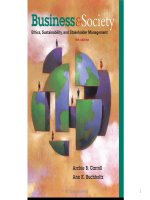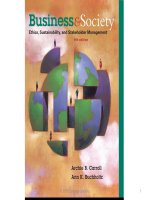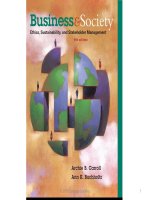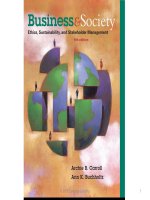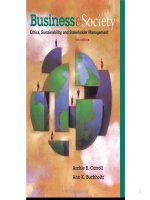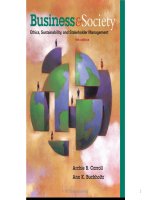Operation management 9e stevenson mcgrwhill chap017
Bạn đang xem bản rút gọn của tài liệu. Xem và tải ngay bản đầy đủ của tài liệu tại đây (297.55 KB, 43 trang )
17
Project
Management
McGraw-Hill/Irwin
Copyright © 2007 by The McGraw-Hill Companies, Inc. All
Learning Objectives
Discuss the behavioral aspects of projects
in terms of project personnel and the
project manager.
Discuss the nature and importance of a
work breakdown structure in project
management.
Give a general description of PERT/CPM
techniques.
Construct simple network diagrams.
17-2
Learning Objectives
List the kinds of information that a PERT or
CPM analysis can provide.
Analyze networks with deterministic times.
Analyze networks with probabilistic times.
Describe activity “crashing” and solve
typical problems.
17-3
Projects
JAN
FEB
MAR
APR
MAY
JUN
Build A
A Done
Build B
B Done
Build C
C Done
Build D
On time!
Ship
Unique, one-time operations designed to
accomplish a specific set of objectives in a limited
time frame.
17-4
Project Management
How is it different?
Limited time frame
Narrow focus, specific objectives
Less bureaucratic
Why is it used?
Special needs
Pressures for new or improves products or
services
17-5
Project Management
What are the Key Metrics
Time
Cost
Performance objectives
What are the Key Success Factors?
Top-down commitment
Having a capable project manager
Having time to plan
Careful tracking and control
Good communications
17-6
Project Management
What are the Major Administrative Issues?
Executive responsibilities
Project selection
Project manager selection
Organizational structure
Organizational alternatives
Manage within functional unit
Assign a coordinator
Use a matrix organization with a project leader
17-7
Project Management
What are the tools?
Work breakdown structure
Network diagram
Gantt charts
Risk management
17-8
Planning and Scheduling
Gantt Chart
MAR
APR
MAY
JUN
JUL
AUG
SEP
OCT
NOV
DEC
Locate new
facilities
Interview staff
Hire and train staff
Select and order
furniture
Remodel and install
phones
Move in/startup
17-9
Key Decisions
Deciding which projects to implement
Selecting a project manager
Selecting a project team
Planning and designing the project
Managing and controlling project resources
Deciding if and when a project should be
terminated
17-10
Project Manager
Responsible for:
Work
Human Resources
Communications
Quality
Time
Costs
17-11
Ethical Issues
Temptation to understate costs
Withhold information
Misleading status reports
Falsifying records
Comprising workers’ safety
Approving substandard work
17-12
Project Life Cycle
Concept
Planning
Execution
Management
Feasibility
Termination
17-13
Work Breakdown Structure
Figure 17.2
Project
Project X
X
Level 1
Level 2
Level 3
Level 4
17-14
PERT and CPM
PERT:
Program Evaluation and
Review Technique
CPM:
Critical Path Method
Graphically displays project activities
Estimates how long the project will take
Indicates most critical activities
Show where delays will not affect project
17-15
The Network Diagram
Network (precedence) diagram – diagram of
project activities that shows sequential
relationships by the use of arrows and nodes.
Activity-on-arrow (AOA) – a network diagram
convention in which arrows designate activities.
Activity-on-node (AON) – a network diagram
convention in which nodes designate activities.
Activities – steps in the project that consume
resources and/or time.
Events – the starting and finishing of activities,
designated by nodes in the AOA convention. 17-16
The Network Diagram (cont’d)
Path
Sequence of activities that leads from the starting
node to the finishing node
Critical path
The longest path; determines expected project
duration
Critical activities
Activities on the critical path
Slack
Allowable slippage for path; the difference the
length of path and the length of critical path
17-17
Project Network – Activity on
Arrow
Figure 17.4
AOA
Locate
facilities
Order
furniture
4
Furniture
setup
2
Remodel
1
5
Interview
3
Move
in
6
Hire and
train
17-18
Project Network – Activity on
Node
Figure 17.4
Order
furniture
AON
Locate
facilities
Furniture
setup
2
6
1
Move
in
Remodel
5
S
Interview
3
7
Hire and
train
4
17-19
Network Conventions
a
c
a
c
b
a
a
c
b
b
b
d
c
Dummy
activity
17-20
Time Estimates
Deterministic
Time estimates that are fairly certain
Probabilistic
Estimates of times that allow for variation
17-21
Example 1
Figure 17.5
8 weeks
ate s
c
Lo ilitie
fac
2
4
er e
d
r
O
tu r
i
n
fur
Rem
ode
l
11 weeks
re
nitu
Fur p
u
set
Deterministic
time estimates
6 weeks
1
3 weeks
5
In
te
rv
i
4 weeks ew
in
a
r
t
Move
in
1 week
6
nd
a
re
Hi
9 weeks
3
17-22
Example 1 Solution
Critical Path
P a th
L e n g th
S la c k
(w e e k s )
1 -2 -3 -4 -5 -6
1 -2 -5 -6
1 -3 -5 -6
18
20
14
2
0
6
17-23
Computing Algorithm
Network activities
ES: early start
EF: early finish
LS: late start
LF: late finish
Used to determine
Expected project duration
Slack time
Critical path
17-24
Probabilistic Time Estimates
Optimistic time
Time required under optimal conditions
Pessimistic time
Time required under worst conditions
Most likely time
Most probable length of time that will be
required
17-25
